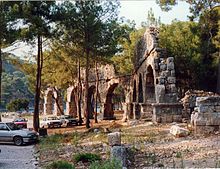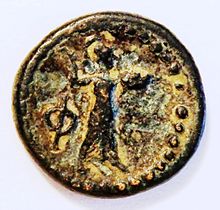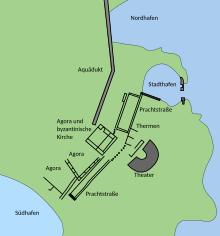Phaselis
Coordinates: 36 ° 31 ' N , 30 ° 33' E
Phaselis ( Greek Φασηλίς ) was an ancient city in Lycia ( Asia Minor , today Turkey ), which was about 53 kilometers southwest of Antalya directly on the coast. It has been archaeologically researched since 1811 and, like Olympos , is located in the Olimpos Beydağları National Park, far from the nearest modern town. As a trading city with three ports in the immediate vicinity of the Persian sphere of influence in Asia Minor, it had until the founding of Attaleia (Antalya) around 150 BC. It was of outstanding importance and was exceptionally wealthy economically. The boulevard, agora , theaters, thermal baths , harbor walls, aqueduct and Byzantine ruins have been preserved.
history
City foundation
The ancient local historian Aristainetos wrote a (now lost) multi-volume work on Phaselis, according to which the Rhodian Lakios is said to have founded the city according to an oracle of the Pythia . Another founding legend reported Philostephanus of Cyrene , according Lakios to the companions of sailing with a fleet to Lycia Argivers Mopsos belonged and was sent out of this for the edification of Phaselis. Lakios had given the shepherd Kylabras salt fish in return for the purchase of the land on which he was to build the city. In any case, Phaselis was a Greek colony . Walther Ruge is of the opinion that the tradition that Phaselis was founded by Dorians from the Rhodian Lindos is preferable to that tradition which traces the city back to a colony leader from Argos. Phaselis is said to have been founded at the same time as that of the Rhodian colony of Gela in Sicily around 690 BC. Be done. It is possible that there was already a Phoenician predecessor settlement on the site of Phaselis .
Classical Greek time
In the first half of the 6th century BC BC Phaselis, which at that time had already developed into an important trading center because of its favorable location, as well as other Greek cities with the permission of Pharaoh Amasis, was represented in the Naukratis trading post in Egypt. a. with Rhodes, Knidos and Halicarnassus . Phaselis, which was considered to be part of Pamphylia in the first centuries of its existence , belonged to about 550 BC. BC for a long time to the Persian Empire. From this time, silver coins minted according to the Persian foot and depicting the front of a ship were found in Phaselis. The fact that the city was under Persian suzerainty was culturally and economically important for them as well as for many other Greek cities in Asia Minor. Politically, however , this was used in Athens as an excuse to camouflage the Athenian activities of the Attic League as an anti-Persian fighting alliance. So Phaselis was around 469 BC. BC by Kimon during his campaign against Persia "exempted" and forced into the League - as a flourishing trading city with high tributes in a strategically important location, a significant gain for Athens.
After Kimon's failed expedition against Cyprus , the Persian-Athenian peace treaty of 449 BC. Chr. The autonomy of the Greek cities agreed and stipulated the condition that Persian warships not up to the coast between Phaselis and at the northern exit of the Bosporus located Kyaneai should sail. 430/429 BC BC, shortly after the outbreak of the Peloponnesian War , the Attic strategist Melesandros sailed with six ships to the coast of Caria and Lycia to secure the sea routes from Athens to Phaselis and Phenicia. Attic merchant ships operating on this route were supposed to be protected against attacks by Peloponnesian privateers. However, Melesandros was killed in a battle in Lycia. 411 BC Phaselis was under the control of the Tissaphernes and had taken up a Spartan occupation under Hippocrates. Sparta had then made an alliance with Persia for its war against Athens. Also Alcibiades then came on his trips to Phaselis.
In the first half of the 4th century BC Phaselis was autonomous, as shown by a contract signed by the city with the Persian satrap of Caria, Maussolos . Phaselis held on to Maussolus when he was fighting the dynast Pericles of Limyra . 334 BC The city surrendered to Alexander the Great when he marched on to southern Asia Minor after his victory on Granikos . He moved into the city and then, together with a contingent of its inhabitants, stormed a robbery of the Pisidians , who had caused a lot of damage to the phaselites from there. According to Pausanias , the temple of Athena, the main sanctuary of the city, contained the spear of Achilles . That too may have been a reason for Alexander to stay here, since he considered himself the "new Achilles". Plutarch reports that on his way home from a drinking bout with his companions, Alexander, intoxicated with wine, decorated the statue of the tragedy poet Theodectes with wreaths on the market square . During his stay in Phaselis, Alexander also learned of the plot of Alexander Lynkestes , but only had him detained for the time being. From Phaselis, Alexander then went on his Asian campaign with one part of the army directly on the Lycian east coast, while his other parts of the army advanced over the "Klimax", a mountain route with rock stairs.
Hellenistic era, Roman rule and the Middle Ages
During the Diadoch Wars, the city was first owned by the Ptolemies after it was conquered by Ptolemy I (309 BC) . The cult of Isis in Phaselis is known through representations on coins minted by the city and proves the Ptolemaic influence. With the conquest of Lycia by Antiochus III. 197 BC Phaselis came under Seleucid rule. According to the Peace of Apamea in 188 BC It was used by the Romans until 167 BC. BC placed under Rhodian rule, together with Lycia, to which Phaselis was officially included from then on. 167 BC The Roman Senate declared Lycia independent and coins testify that Phaselis was at least in the period from 138 to 104 BC. Was a member of the Lycian League . The location of the city on the border between the Pamphylian and Lycian seas contributed to the fact that it was built in the early 1st century BC. Became a loophole for Cilician pirates . Their leader Zeniketes established himself here. Publius Servilius Vatia took 77 BC. Started the fight against the pirates and captured Phaselis, among others, which suffered great destruction. After Pompey 48 BC After he had lost the battle of Pharsalus against Caesar , Lucan said that he also stopped at Phaselis and stayed there briefly. According to Lucan, the city had only a small population at that time, apparently as a result of the devastation by Servilius Vatia. According to Plutarch, however, Pompey did not end up with Phaselis, but with Attalia, and Lucan's statement could arise from a poetic freedom. When Brutus in the spring of 42 BC BC came to Lycia to collect money for the fight against Mark Antony and Octavian and to raise troops, he destroyed the opposing Xanthos , after which besides Patara , Myra and Korykos also Phaselis surrendered.
Under Domitian , Trajan and Hadrian , the city, which was destroyed in the pirate wars, was rebuilt in a representative manner at the end of the 1st century AD and experienced a second heyday. Most of the ruins that are preserved today date from this period. Hadrian visited the city around 129 AD. To commemorate this stay, a building with statues of the emperor was built in Phaselis, some of which have been preserved on the base. There was coinage in the city at least until the reign of the emperor Gordian III, who died in 244 . In the 3rd and 4th centuries, invasions by the Isaurs and increased pirate mischief caused the city to decline; and Phaselis never recovered from the later raids of the Arabs in the 7th century, even though it temporarily rose again as a Byzantine naval base in the 8th century. From the 10th century it was only used as a quarry for Antalya, which needed material for its fortifications. In 1158 the Seljuks took possession of the city, which finally ceased to exist.
Excavations
Phaselis is located on a small peninsula at the foot of the Taurus Mountains . The little hinterland is largely swampy. Phaselis owes its unique importance as a city with three largely natural harbors to its special shape. The ancient breakwaters can still be seen in the large northern harbor . This is also where the well-preserved imperial aqueduct leads along 400 meters to the city.
The so-called city harbor with its mighty quay walls is a popular bathing bay today. From there, the more than 20-meter-wide boulevard with the important Roman buildings on both sides leads to the southern harbor, which is protected by a wall. On the northwest side, the three agors (marketplaces) from the times of Hadrian, Domitian and late antiquity are lined up. There are also remains of the thermal baths and Byzantine ruins. On the opposite south-east side, the city theater was built on a hillside. The Acropolis of Phaselis located above still shows the remains of the houses of the last inhabitants who had abandoned the city since the 7th century and holed up on the ridge. The remaining residential areas with streets and houses have been almost completely demolished.
sons and daughters of the town
Theodectes , born around 400 BC Was a speechwriter and playwright in Athens. He took 353 BC In Halicarnassus at the funeral ceremonies for Mausolus in a speech contest. In Athens he met the young Aristotle , who later became Alexander the Great's teacher. When he came to Phaselis, Theodectes was already dead. Phaselis erected a statue for his famous citizen on the agora.
literature
- Walther Ruge : Phaselis. In: Paulys Realencyclopadie der classischen Antiquity Science (RE). Volume XIX, 2, Stuttgart 1938, Sp. 1874-1883.
- George Ewart Bean : Phaselis (Tekirova) Turkey . In: Richard Stillwell et al. a. (Ed.): The Princeton Encyclopedia of Classical Sites. Princeton University Press, Princeton NJ 1976, ISBN 0-691-03542-3 .
- Jörg Schäfer (Ed.): Phaselis. Contributions to the topography and history of the city and its ports (= Istanbuler Mitteilungen. Supplement 24). Wasmuth, Berlin 1981, ISBN 978-3-8030-1723-9 .
Web links
- Description, pictures and plans of Phaselis
- Coins of Phaselis (English)
- Documentation Phaselis (German)
Remarks
- ↑ a b Aristainetos, FGrH No. 771, F 1 with Stephanos of Byzantium , Ethnika , s. Gela .
- ↑ Philostephanos in Athenaios , Deipnosophistai 7, 51, p. 297 f - 298 a.
- ↑ Cicero , In Verrem 2, 4, 21; Plutarch , Kimon 12, 3.
- ↑ Athenaios, Deipnosophistai 7, 51, p. 297 f; Stephanos of Byzantium , Ethnika , s. Gela .
- ↑ Walther Ruge: Phaselis. In: Paulys Realencyclopadie der classischen Antiquity Science (RE). Volume XIX, 2, Stuttgart 1938, Sp. 1874-1883 (here: Sp: 1876).
- ↑ a b Phaselis. In: The New Pauly (DNP). Volume 9, Metzler, Stuttgart 2000, ISBN 3-476-01479-7 , column 756.
- ^ Herodotus , Historien 2, 178 ( English translation ).
- ↑ Walther Ruge: Phaselis. In: Paulys Realencyclopadie der classischen Antiquity Science (RE). Volume XIX, 2, Stuttgart 1938, Sp. 1874-1883 (here: Sp: 1877).
- ↑ Plutarch, Kimon 12, 3 f.
- ^ Lykurgos , Against Leocrates 73; Isocrates , Orationes 4, 118; 7, 80; 12; 59; Diodor , Bibliothḗkē historikḗ 12, 4, 5.
- ^ Thucydides , Peloponnesian War 2, 69.
- ↑ Thucydides, Peloponnesian War 8, 88; 8.99; 8, 108.
- ↑ a b Walther Ruge: Phaselis. In: Paulys Realencyclopadie der classischen Antiquity Science (RE). Volume XIX, 2, Stuttgart 1938, Sp. 1874-1883 (here: Sp: 1878).
- ^ Polyainos , Strategemata 5, 42.
- ↑ Arrian , Anabasis 1, 24, 5 f.
- ^ Pausanias, Description of Greece 3, 3, 8.
- ^ Plutarch, Alexander 17, 9.
- ↑ Arrian, Anabasis 1, 25; on this Alexander Demandt : Alexander the Great. Life and legend. CH Beck, Munich 2009, ISBN 978-3-406-59085-6 , p. 126.
- ↑ Arrian, Anabasis 1, 26, 1 f .; Plutarch, Alexander 17, 6 ff .; Strabon , Geographika 14, 666 f .; on this Siegfried Lauffer : Alexander the Great (= dtv. 4298, dtv science ). 3. Edition. Deutscher Taschenbuch-Verlag, Munich 1993, ISBN 3-423-04298-2 , p. 69.
- ↑ Diodor, Bibliothḗkē historikḗ 20, 27, 1.
- ↑ a b George Ewart Bean : Phaselis (Tekirova) Turkey . In: Richard Stillwell et al. a. (Ed.): The Princeton Encyclopedia of Classical Sites. Princeton University Press, Princeton NJ 1976, ISBN 0-691-03542-3 .
- ↑ Phaselis. In: The New Pauly (DNP). Volume 9, Metzler, Stuttgart 2000, ISBN 3-476-01479-7 , column 757.
- ↑ Strabon, Geographika 14, 671; Florus , Epitoma de Tito Livio 1, 41, 5; Eutropius , Breviarium ab urbe condita 6, 3; Orosius , Historiae adversum paganos 5, 23, 22; Pseudo- Asconius and Schol. Gronov. to Cicero, In Verrem p. 237, 25 and 347, 2.
- ↑ Lucan, Pharsalia 8, 251 f.
- ↑ Plutarch, Pompey 76, 1.
- ↑ So Franz Miltner : Pompeius 31. In: Paulys Realencyclopädie der classischen Antiquity Science (RE). Volume XXI, 2, Stuttgart 1952, Col. 2062-2211 (here: 2201).
- ↑ Matthias Gelzer : Iunius 53. In: Paulys Realencyclopädie der classischen antiquity science (RE). Volume X, 1, Stuttgart 1918, Sp. 973-1020 (here: 1011 f.).
- ↑ Walther Ruge: Phaselis. In: Paulys Realencyclopadie der classischen Antiquity Science (RE). Volume XIX, 2, Stuttgart 1938, Sp. 1874-1883 (here: 1880).





